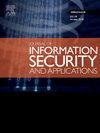A nano-design of image masking and steganography structure based on quantum technology
IF 3.7
2区 计算机科学
Q2 COMPUTER SCIENCE, INFORMATION SYSTEMS
Journal of Information Security and Applications
Pub Date : 2025-09-23
DOI:10.1016/j.jisa.2025.104221
引用次数: 0
Abstract
Secure image storage and transmission require sound encryption methods that resist key exposure while maintaining high image quality. Various encryption approaches have been developed to protect image content and its transmission from unauthorized access. One such method is image masking, where a special mask is generated to conceal information within the original image. Instead of hiding the image visually, the mask creates an intermediate layer that obfuscates the encryption key, eliminating the need to transmit it directly. However, implementing such masking techniques efficiently at the hardware level poses particular challenges. Traditional Complementary Metal-Oxide-Semiconductor (CMOS)-based Very-Large-Scale-Integration (VLSI) systems face scalability issues, excessive heat, and high-power consumption. To overcome these challenges, this study utilizes a nano-scale image masking architecture based on Quantum-dot Cellular Automata (QCA), offering reduced area, lower power dissipation, and faster processing. The core operations utilize a three-input XOR gate, designed as a single-layer QCA structure without rotated cells. While QCA-based approaches improve hardware efficiency, most existing implementations focus only on grayscale images, leaving a gap in colorful image encryption. To address this, the work presents a QCA-based encryption and masking architecture for colored images. The method encrypts an image using a random key to generate a cipher image, which is then XORed with the original image to produce a mask. This process, applied independently to each RGB channel, produces three cipher-mask pairs, embedding steganographic property by concealing key information within the image. The keys are generated using a true random number generator (TRNG) based on cross-coupled loops and cross-oriented structures, ensuring high entropy. The design was modeled in QCADesigner 2.0.3, with the encryption/decryption algorithms implemented in Python. Experimental results demonstrated a meaningful reduction in cell count and consumed area compared to the prior designs. Image quality and security analysis confirmed visual fidelity and improved robustness.
基于量子技术的图像掩蔽和隐写结构的纳米设计
安全的图像存储和传输需要可靠的加密方法,以防止密钥暴露,同时保持高图像质量。已经开发了各种加密方法来保护图像内容及其传输免受未经授权的访问。其中一种方法是图像掩蔽,即生成一个特殊的掩码来隐藏原始图像中的信息。掩码并没有在视觉上隐藏图像,而是创建了一个中间层来混淆加密密钥,从而消除了直接传输密钥的需要。然而,在硬件级别有效地实现这种屏蔽技术带来了特殊的挑战。传统的基于互补金属氧化物半导体(CMOS)的超大规模集成电路(VLSI)系统面临着可扩展性、过热和高功耗等问题。为了克服这些挑战,本研究利用基于量子点元胞自动机(QCA)的纳米级图像掩蔽架构,提供更小的面积,更低的功耗和更快的处理速度。核心操作利用三输入异或门,设计为单层QCA结构,没有旋转单元。虽然基于qca的方法提高了硬件效率,但大多数现有的实现只关注灰度图像,在彩色图像加密方面留下了空白。为了解决这个问题,本研究提出了一种基于qca的彩色图像加密和屏蔽架构。该方法使用随机密钥对图像进行加密以生成密码图像,然后将其与原始图像进行xor以生成掩码。该过程独立应用于每个RGB通道,产生三个密码掩码对,通过隐藏图像内的密钥信息嵌入隐写特性。密钥使用基于交叉耦合环和交叉定向结构的真随机数生成器(TRNG)生成,确保了高熵。该设计在qcaddesigner 2.0.3中建模,加密/解密算法在Python中实现。实验结果表明,与先前的设计相比,在细胞计数和消耗面积上有意义的减少。图像质量和安全性分析证实了视觉保真度和鲁棒性的提高。
本文章由计算机程序翻译,如有差异,请以英文原文为准。
求助全文
约1分钟内获得全文
求助全文
来源期刊

Journal of Information Security and Applications
Computer Science-Computer Networks and Communications
CiteScore
10.90
自引率
5.40%
发文量
206
审稿时长
56 days
期刊介绍:
Journal of Information Security and Applications (JISA) focuses on the original research and practice-driven applications with relevance to information security and applications. JISA provides a common linkage between a vibrant scientific and research community and industry professionals by offering a clear view on modern problems and challenges in information security, as well as identifying promising scientific and "best-practice" solutions. JISA issues offer a balance between original research work and innovative industrial approaches by internationally renowned information security experts and researchers.
 求助内容:
求助内容: 应助结果提醒方式:
应助结果提醒方式:


